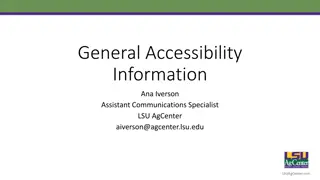Debunking Myths on Low-Level Speeding and Road Safety
Exploring the relationship between speed limits, kinetic energy, impact speeds, and injury prevention in road accidents. Highlights the impacts of speed on crash rates, the importance of managing energy exchange for safety, and the paradox of preventive medicine in promoting healthy behaviors. Emphasizes the need to address low-level speeding and change societal behavior for improved road safety.
Uploaded on Dec 05, 2024 | 0 Views
Download Presentation

Please find below an Image/Link to download the presentation.
The content on the website is provided AS IS for your information and personal use only. It may not be sold, licensed, or shared on other websites without obtaining consent from the author.If you encounter any issues during the download, it is possible that the publisher has removed the file from their server.
You are allowed to download the files provided on this website for personal or commercial use, subject to the condition that they are used lawfully. All files are the property of their respective owners.
The content on the website is provided AS IS for your information and personal use only. It may not be sold, licensed, or shared on other websites without obtaining consent from the author.
E N D
Presentation Transcript
Exploding the Myths around Low Level Speeding Ian Johnston July 2013
Kinetic Energy is the immediate cause of injury - managing energy exchange is the principal goal (thank God for Newton!)
Maximum Impact Speeds Car/pedestrian 30 km/h Car/motorcyclist 30 km/h Car/tree or pole 40 km/h Car/car (side-impact) 50 km/h Car/car (head-on) 70 km/h Source: Tingvall & Howarth (1999); Wramborg (2005)
Speed and Safety A huge research literature has this rule of thumb bottom line A 5% decrease in average speed leads to approximately a 10% decrease in all injury crashes and a 20% decrease in fatal crashes (has survived in the toughest school of all peer review)
Deaths in Melbourne 1999 & 2000 2003 & 2004 435 307 Total Vulnerable road users 175 106 Vehicle occupants 260 201
Preventive Medicine (1) Does everyone who: smokes get lung cancer? is obese get heart disease? exceeds the speed limit crash? and the reverse is everyone who gets lung cancer a smoker?
The Health Prevention Paradox Rose: .. (the) irony of preventive medicine is that many people must take precautions to prevent illness in only a few. Why is .05 our BAC limit? Why Random Breath Testing?
Preventive Medicine (2) When a small individual risk is widespread we must change behaviour of the population So folk wear belts and helmets and accept RBT but we can t get them to slow down! Why not?
We fight like hell when there is assumed to be a personal cost Low level speeding the classic example Assumed to cost time, to be frustrating, etc all go against the increasing pace of life After years and years of enforcement tolerances speed limits have lost the concept of limit
Not Rocket Science! Research is clear Higher speed = greater crash risk and more severe crashes Preventive Medicine principles are clear Must change population behaviour Tackle all obstacles (social change) Intense enforcement but with powerful supporting education























